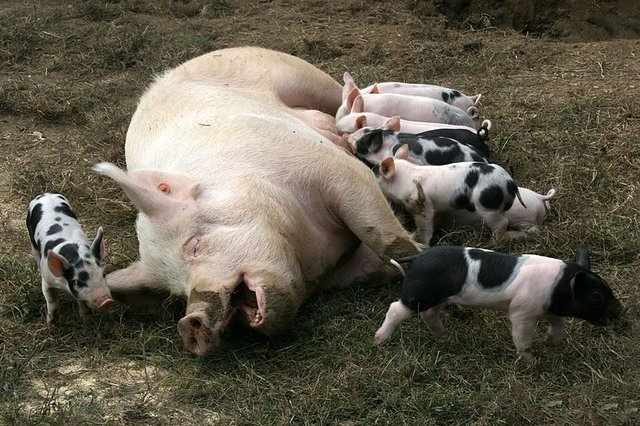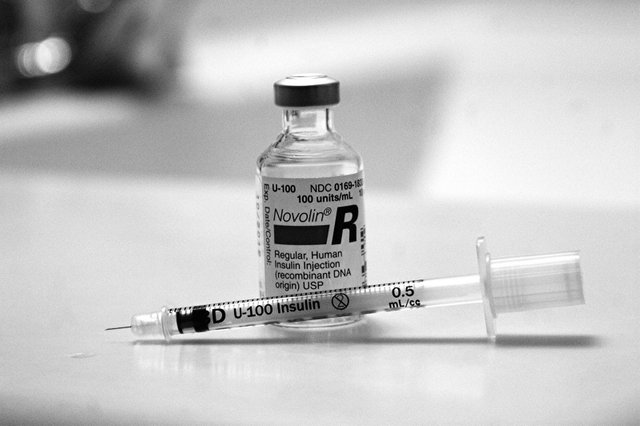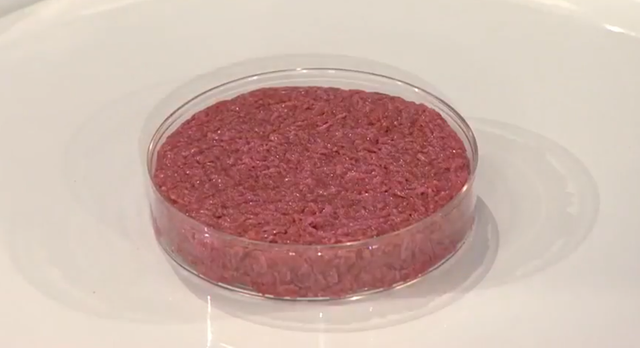Cellular Agriculture: The 'farming' revolution
 A lactating pig [Source: Wikipedia Creative Commons] - Public domain
A lactating pig [Source: Wikipedia Creative Commons] - Public domainGood day esteemed readers. I want to sincerely appreciate those who took their time to read my introductory post. The comments, reviews are encouraging and I'm overwhelmed by the kind gesture. I'm sorry I've not updated my blog since then due to some reasons, I assure you that it will only get better.
There's a wonderful feeling of eureka when you complete a task, better, in many ways when compared to the common method.
I read in an article sometimes ago that the union between biology and technology (biotechnology) is still in the stone age even at this present century that we find ourself. This implies that there is still much to be done in terms of research to unravel the massive benefits we can get from this union. The topic today is about one of the blessings this union has come up with in cellular agriculture.
Interestingly, there's more into cellular agriculture than just bio-technology, where the intersection of other disciplines such as tissue engineering, molecular and synthetic biology come into play. This technology makes it possible to obtain genuine agricultural products without having to tamper with pillars of agriculture - plant and in this case animals.
What then is cellular agriculture?
Cellular agriculture is the farming of agricultural products from cell cultures. Technically speaking, cellular agriculture uses the technology in which real dairy products are obtained without exploiting or slaughtering living animals. Yes, you read that right! Meat without killing, milk without touching the udder of livestocks and several other animal products. Clearly, we can't talk about cellular agriculture without talking about cells.
The cell is the bases of life just as scientific principles is the bases of engineering design.
Throughout history and even now, animals, plants and various microorganisms are being, bred, cross bred, and studied; under controlled environment just to improve their hereditary/genetic makeup to meet the desired needs such as adaptation to the environment, better milk and meat production, desired quality meat and enhance productivity.
My mum; a dairy scientist, worked on two Sheep breeds (the Yankasa and West African dwarf). The Yankasa sheep are mostly found in Northern part of Nigeria, having large body size, produce milk in large quantity but are susceptible to tsetse fly prevalent in the west while the West African Dwarf are on the contrary; found in the south western part, small in size, produce milk in low quantity but have strong immunity against diseases.
The research came out with a strain that combined the ups of the two breeds into one. This brief outlook is just to familiarise ourselves and see how genetechnology is being applied in livestock farming and to outline the correlation between the conventional method and it's application in cellular agriculture
There are different products that can be harvested from cellular farming which are grouped into two main classes namely; acellular and cellular products.
Acellular products
Acellular animals products are those obtained when protein genes are inserted into microbes (host organism) such as yeast, bacteria or other fungi to grow such proteins i.e under controlled environment (in a bioreactor), the microbe (with inserted protein gene) is grown in large quantities to bring about a corresponding growth multiplication in the inserted protein.
There are two main principles backing the possibility of making these products. One is the advent of DNA sequencing which allows the identification of the required gene from a sequence database resulting in the manufacturing of DNA to the precise specifications for introduction into the microbes and the second is that all organisms possess similarity in the way they read gene and translate it into protein.
Once sequencing is done to determine the precise gene, this gene is being introduced into the microbe, forming a starter culture.

You can just imagine how many pigs will be on the execution list just to make use of a gland which is not up to 0.6% of its body size.
Another product is rennet which can be animal or vegetable based coagulants vital in cheesemaking. Loving cheese is just as synonymus to loving rennet. Without rennet, there won't be cheese!
Naturally occurring rennet in animal is an enzyme in the stomach of young ruminant. Chymosin, its key component, is a protease enzyme that curdles the casein in milk which makes it a good option in producing cheese. Sadly, vegetarians won't taste your cheese made with amimal rennet!
Another type, thee vegetable rennet (from fig leaves, sunflower etc) will curdle milk but won't produce a fine quality cheese.
This makes the genetically engineered rennet (known as fermentation produced chymosin) approved by the FDA in 1990 to be a perfect substitute for the animal, vegetable rennet.
Other examples of acellular products include the casein (a cow-free milk), gelatin (for food and pharmaceutical use), albumin, vanillin.
Cellular products
Cellular products are obtained by bringing together the idea of cell structures and the framework of medical tissue engineering into food production. Main agricultural product such as meat, leather, fur, wool and some other agricultural products are obtained through this process. The difference between the cellular and acellular products is that that the gene in making cellular products is taken directly from the donor organism and not from a manufactured database. Meaning that cellular products are made by culturing the extracted cell of living or once living animal.
At conception of research into cellular products, scientist and tissue engineers were only interested in its application to medicine i.e regeneration of biological materials that will be able to integrate properly into the body just like the organ or tube it intends to replace and also be accepted by the immuno-system. With success attained in the growing of functional organs such as the skin to fit into people, further research now seek to answer the question of how sensory properties such as flavour, texture, colour and taste can be improved upon, keeping in mind the required nutrition.

Pork is the most widely consumed meat in the world, followed by poultry, beef, and mutton therefore it is easy to say that the most popular cellular product is the cultured meat. Cultured or in-vitro meat is produced by collecting stem cells from animals, which are subsequently grown in a nutrient serum solution in the bioreactor to create strands (strips of muscle fibre) of small muscle skeletal tissue.
Due to the lack of vessels in cultured meat, the tissues can only reach a length of about 0.5 mm thickness reason why initial groundbreaking research focuses on its use as hamburger patties and meatballs, rather than whole-muscle prouts. Recent research is making it possible to culture three-dimensional meat instead of strips; the cells are grown on an edible scaffold in the bioreactor.

Some, out of the numerous benefits of cellular agriculture are the great reduction in the killings, intense confinement, castration without painkillers, Illness without veterinary care or euthanasia, trampling and suffocation from overcrowding, transportation through long distances. Our thought as human won't be to exploiting livestock but to see them as another beauty of creation to be nurtured.
Cellular agriculture also gives room for human to maintain dietary preferences while removing many of the inefficiencies and harms of contained in food products - cholesterol-free egg, lactose-free milk.
Another plus is the controlled conditions used in growing cultured meat improves food safety by minimizing animal-borne diseases and pathogens, such as Salmonella, Campylobacter and E. coli.
In summary, cellular agriculture is spearheading a revolution in the agricultural sector paving way not only for sustainable food production but also food security. Although there is still some real work to be done in terms of research, to perfect its reality, media and cultural view, affordability, and changing individual's perception towards these products. With this nascent scientific discipline the numerous potential and present gains far out ways the skepticism surrounding it and soon the revolution will be encompassing.
Reference
- Achla Khanna et al 2018. Cellular Agriculture The Future of food A Report.
- Danielle Nierenberg (2011). Global Meat Production and Consumption Continue to Rise
- Ginger Huktin (2017). Lab-grown Meat: Exploring Potential Benefits and Challenges of Cellular Agriculture
- Hoogenkamp, H (2016). Cellular agriculture shows future potential.
- Phil Lempert (2017). Cellular Agriculture: A great impact on formulations.
- Siegelbaum, D.J. (2008). In Search of a Test-Tube Hamburger.
- Valentin Waschulin and Liz Specht 2018 Cellular agriculture: An extension of common production methods for food.
- Wikipedia: Cultured meat.
Special thanks to @addempsea for his supoort while writing this post
This post has been voted on by the SteemSTEM curation team and voting trail in collaboration with @curie.
If you appreciate the work we are doing then consider voting both projects for witness by selecting stem.witness and curie!
For additional information please join us on the SteemSTEM discord and to get to know the rest of the community!
Dear friend, you do not appear to be following @wafrica. Follow @wafrica to get a valuable upvote on your quality post!
First i'd like to say welcome back, its been a while since you wrote your introductory post.
I've been anticipating your next post and what a way to satisfy my anticipation with such an educative post, welcome back once again and i hope you are here to stay.
Thanks a million @thurllanie
Yeah its been a while. I hope to stay now Bro
I am not of much an agricultural person but going through this article has stir up a desire in me. I am aware of some of these agricultural benefits but i never knew cellular agriculture is responsible. Interesting piece! I believe if you keep up at this pace, steem community will be glad to have you
Cellular agriculture has been for sometime now. Dating back to the early 90s. The approval by FDA and commercialisation of insulin and rennets highlights it as a research worth delving into. The cultured meat is particularly proving tough but soon, the research will be worth it. Thank you for reading through, I'm humbled @sunkanmi02
Congratulations @adewumi! You have completed the following achievement on the Steem blockchain and have been rewarded with new badge(s) :
Click here to view your Board of Honor
If you no longer want to receive notifications, reply to this comment with the word
STOPTo support your work, I also upvoted your post!
Do not miss the last post from @steemitboard:
Congratulations @adewumi! You have completed the following achievement on the Steem blockchain and have been rewarded with new badge(s) :
Click here to view your Board of Honor
If you no longer want to receive notifications, reply to this comment with the word
STOPDo not miss the last post from @steemitboard:
Congratulations @adewumi! You have completed the following achievement on the Steem blockchain and have been rewarded with new badge(s) :
Click here to view your Board of Honor
If you no longer want to receive notifications, reply to this comment with the word
STOPDo not miss the last post from @steemitboard:
Congratulations @adewumi! You have completed the following achievement on the Steem blockchain and have been rewarded with new badge(s) :
Click here to view your Board of Honor
If you no longer want to receive notifications, reply to this comment with the word
STOPDo not miss the last post from @steemitboard: